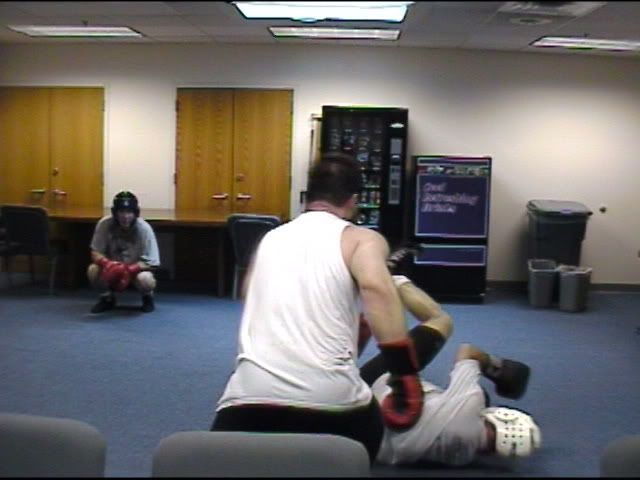 One pitfall of martial arts training is that it takes us away from the realistic, especially what we're likely to face from an untrained opponent. Don't get me wrong, I'm all for learning how to do a jump-away side kick versus a cartwheel kicking attacker, or with learning the latest counter to an omoplata, but how often will that occur? What are we likely do deal with, and how should we prepare to respond? Hock Hochheim has been cautioning martial artists for years to avoid the trap of spending most of our time preparing for advanced attacks and little time versus the untrained, and he's right. One of the reasons is that it's very different, akin to dealing with a beginner in the martial arts, but one with more confidence, and that's dangerous!
One pitfall of martial arts training is that it takes us away from the realistic, especially what we're likely to face from an untrained opponent. Don't get me wrong, I'm all for learning how to do a jump-away side kick versus a cartwheel kicking attacker, or with learning the latest counter to an omoplata, but how often will that occur? What are we likely do deal with, and how should we prepare to respond? Hock Hochheim has been cautioning martial artists for years to avoid the trap of spending most of our time preparing for advanced attacks and little time versus the untrained, and he's right. One of the reasons is that it's very different, akin to dealing with a beginner in the martial arts, but one with more confidence, and that's dangerous!
So how do most attacks begin? Other than muggings, most have a yapping period, wherein dominance and intimidation are the goal, then the physical begins with a shove, grab and punch, sucker punch, or tackle.
How should you prepare?
You may find that some of the counters and defenses we experimented with in this training diary post will help a lot:
Vs. Tackle: Angle off and push the attacker's head so that he careens to the side.
Vs. Right haymaker: duck under and attack from the side or behind.
Vs. Infighting: Dive position blocking, then grab attacker behind the neck and pull into the knee and elbows.
Stop-hit the wide shot with a jab: All the straight punches I threw worked pretty well when I could get in position to throw them. If you follow the quick hard jab with a follow-through right, I think this is when you could move into position for a throw. I want to work on that more. I told Sam that when I was throwing the jab, I was visualizing using either the jab to the nose, or a strike to the throat. Sam commented that this was very effective against him.
Leg-kicking: I tried it only a couple of times, but it seemed very effective. Sam commented that when he was throwing a right and I sidestepped and leg-kicked, that if I'd landed hard it would've taken him off his feet.
Grab and knee: We both used this to good effect. If an opponent is flailing with punches and wants to get inside, the best thing was to let him in, block his punches while clinching behind the neck, then repeatedly kneeing to the thighs, groin and midsection.
Lateral movement: Seems like just movement threw off the attacker quite a bit.
Some techniques to try are, wedge (dive position) block, lead palm strike/eye jab with high elbow to deflect the blow, and a simultaneous block and counter (palm to the nose/web-hand to the throat/palm to the forehead).
The article mentioned in this post had some good advice: "Don't pace yourself ("63 percent were resolved in less than 10 seconds"). I have never seen a real fight that went 12 rounds. If you beat your opponent to the punch, you will probably survive. Have you ever watched the toughman contests they had on Spike TV? They most closely resembled a real fight, in that the fighter who lands the best punch first will win. Now, I would change that to say that, if you can grapple, it gives you other options, but don't wait around to figure them out!"
Don't worry about footwork (if you're trained): "...an experience fighter won't have to worry about footwork precisely because of that experience. A novice or untrained person's footwork may be what gets him or her in trouble."
Finally, my advice is to set aside some time to drill versus the untrained attack. Don't ignore the fact that your adversaries may have some training, but don't assume it.

2 comments:
Great post Nathan. Love tips like this. Keep 'em coming!
Nat - thought to recycle and keep some of your threads alive on my blog. :-) Check out the response at Self Defence: TDA Tip
Post a Comment